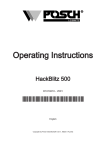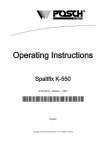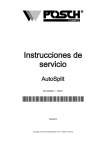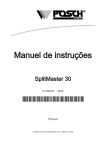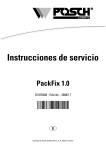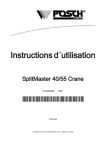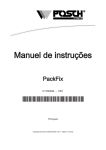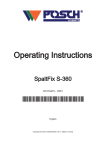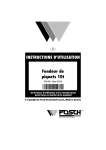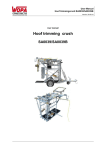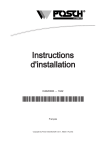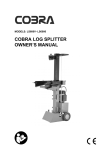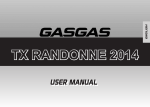Download AutoSplit 350
Transcript
Operating Instructions AutoSplit 350 D1010471 - Edition - V001 *D1010471-V001* English Copyright by Posch Gesellschaft m.b.H., Made in Austria Manufacturer Manufacturer POSCH Gesellschaft m.b.H. Paul-Anton-Keller-Strasse 40 A-8430 Leibnitz Tel.: +43 (0) 3452/82954 Fax: +43 (0) 3452/82954-53 E-mail: [email protected] http://www.posch.com © Copyright by POSCH Gesellschaft m.b.H., Made in Austria Please be sure to fill this in before starting. Then you can be sure that this document relates to your machine, so if you have any queries you will be given the correct information. Machine number:.............................................................................. Serial number:..................................................................................... POSCH Austria: 8430 Leibnitz, Paul-Anton-Keller-Strasse 40, telephone: +43 (0) 3452/82954, fax: +43 (0) 3452/82954-53, e-mail: [email protected] POSCH Germany: 84149 Velden/Vils, Preysingallee 19, telephone: +49 (0) 8742/2081, fax: +49 (0) 8742/2083, e-mail: [email protected] 2 Contents Contents 1 Foreword 5 1.1 Copyright notice 5 1.2 Liability for defects 5 1.3 Reservations 5 1.4 Definitions 5 1.5 Operating instructions 6 2 Safety information 7 2.1 Explanation of symbols 7 2.2 General safety information 8 2.3 Safety instructions for log splitter 8 2.4 Noise 9 2.5 Remaining risks 9 2.6 Proper use 9 2.7 Incorrect use 9 3 General 10 3.1 Scope 10 3.2 Description 10 3.3 The most important components of the machine 11 3.4 Stickers and their meaning 12 3.5 Set-up 13 4 Start-up 14 4.1 Driven by electric motor (type E) 14 4.2 Driven by tractor via universal joint shaft (type PZG) 15 5 Operation 17 5.1 Feed tray 17 5.2 Step 18 5.3 Main controls 18 5.4 Setting the billet size 19 5.5 Splitting 19 6 Switching off the machine 21 7 Transport 22 8 Checks 23 8.1 Protective guards 23 8.2 Screw fittings 23 8.3 Hydraulic lines 23 3 Contents 4 8.4 Oil level 23 9 Maintenance 24 9.1 Lubrication 24 9.2 Oil changing 24 9.3 Feed belt 26 9.4 Cleaning 26 10 Additional equipment 27 10.1 Packing chute 27 11 Troubleshooting 28 12 Technical data 30 13 Service 31 EC Declaration of Conformity 32 Foreword 1 Foreword Thank you for buying our product. This machine has been built in conformity with applicable European standards and regulations. These operating instructions explain how to operate the machine safely and efficiently and how to maintain it. Any person entrusted with the transport, installation, commissioning, operation or maintenance of the machine must have read and understood: ▪ the operating instructions ▪ the safety instructions ▪ the safety information given in the individual chapters. To avoid operator error and ensure problem-free operation, the operating instructions must be available to the operating personnel at all times. 1.1 Copyright notice All documents are protected by the law of copyright. Documents including excerpts thereof may not be distributed or reproduced nor may their content be communicated without express permission. 1.2 Liability for defects Read these operating instructions through carefully before putting the machine into operation. We accept no liability for damage or disruptions caused by failure to observe the operating instructions. Claims for liability must be reported as soon as the defect is identified. Claims are null and void for example in the following cases: ▪ improper use ▪ faulty attachments and drives not supplied with the machine ▪ failure to use original spare parts and accessories ▪ conversions or modifications, where not agreed with us in writing We are not liable for defects of wearing parts. 1.3 Reservations Technical data, dimensions, illustrations of the machine and safety standards are subject to continual change and are therefore not in any circumstances binding in relation to the supplied machine. We accept no liability for printing and typesetting errors. 1.4 Definitions Operator The operator is the party which operates the machine and uses it for its intended purpose or causes it to be operated by suitable, trained personnel. Operating personnel 5 Foreword The operating personnel (operators) are those entrusted by the operator to operate the machine. Technical personnel Technical personnel are persons entrusted by the operator of the machine with special tasks such as installation, set-up, maintenance and troubleshooting. Electrician An electrician is a person who, by virtue of his specialist training, has knowledge of electrical systems, standards and regulations and is able to identify and prevent possible hazards. Machine The term machine replaces the commercial designation of the object to which these operating instructions relate (see cover sheet). 1.5 Operating instructions This manual is a "translation of the original operating manual" 6 Safety information 2 Safety information 2.1 Explanation of symbols The following symbols and instructions in this manual provide warnings about possible personal injury or property damage or give useful information about working with the machine. DANGER Warning about danger zones Instruction regarding safe working, where non-compliance entails the risk of serious or fatal injury. Always observe these instructions and ensure that you work with particular caution and care. DANGER Warning of dangerous electrical voltage Contact with live parts can result in immediate death. Protective covers and enclosures marked with this sign may only be opened by qualified electricians after the electricity supply has been turned off. DANGER Crushing hazard Risk of injury through upper limbs getting trapped. NOTICE Instruction Symbol for proper use of the machine. Non-observance can result in malfunctions by or damage to the machine. Noise Symbol for an area where noise levels can exceed 85 dB(A). Non-observance can cause hearing problems or deafness. Further information Symbol for further information relating to a bought-in part. 7 Safety information Information Action-related information. 2.2 General safety information The machine may only be operated by persons who are familiar with the machine’s operation and hazards and with the user manual. ▪ It is the operator’s responsibility to provide appropriate staff training. Persons under the influence of alcohol, drugs or pharmaceutical products that impair responsiveness must not operate or maintain the machine. The machine may only be operated if it is in perfect working condition. Only operate the machine if it is in a stable position. Minimum age of operative: 18 years. Only one person may operate the machine at a time. Take regular breaks to ensure concentration. Ensure that your workplace is adequately illuminated since poor lighting can significantly increase the risk of injury. Never work without the protective guards in place. Only carry out repair, setup, maintenance and cleaning work when the drive is switched off and the tool is stationary. ▪ If the machine has a PTO drive, the universal joint shaft must be removed from the tractor. ▪ If the machine is driven by an electric motor, set main switch to 0 and disconnect the power cable. Never leave the machine running unattended. Switch off the machine's drive unit before carrying out any adjustments. Only use original - POSCH - spare parts. Do not modify or tamper with the machine. Work on electrical equipment must only be carried out by qualified electricians. Never use damaged cables. Machines with electric motors must not be used in the rain as this can lead to a malfunction of the switch or the motor. 2.3 Safety instructions for log splitter Only use the machine outdoors. Wear safety shoes and close-fitting clothes when working with this device. Never split angle-cut wood. Wear protective gloves. Keep the work area free of chips and wood residues. Shut the drive down before removing any jammed pieces of wood. Max. log length 25 - 33 cm The working pressure of the hydraulic system must not exceed 200 bar. 8 Safety information 2.4 Noise The workplace-related, A-rated emission sound pressure level is 85 dB(A), measured at the operative's ear. In the case of machines with a PTO drive, the noise level depends on the noise of the tractor. Ear protection is therefore necessary. The stated values are emissions values, and thus do not necessarily represent reliable values for the work area. Although there is a correlation between emission and pollutant levels, it is not possible to deduce reliably from that whether or not additional precautionary measures are necessary. Factors that influence the level of pollutants present in the work area include the individual nature of the work area, other sources of noise, e.g. the number of machines and other work operations being carried out in the vicinity. Equally, permissible values for a work area may vary between different countries. However, this information should enable the user to estimate the dangers and risks more accurately. 2.5 Remaining risks Even if all safety precautions are observed and the machine is used in accordance with the instructions, some risks still remain: ▪ Touching of revolving parts or tools. ▪ Injury caused by flying logs or log pieces. ▪ Risk of burns if the engine is not properly ventilated. ▪ Hearing loss if ear protection is not worn when working. ▪ Human error (e.g. due to excessive physical exertion, mental strain, etc.) With every machine, some risks still remain. Therefore you should always be very careful when working. It is up to the operating personnel to ensure that work is carried out safely. 2.6 Proper use The machine - AutoSplit - is designed exclusively for splitting logs with a diameter of 10 35 cm and a length of 25 - 33 cm. The machine may only be used to process firewood. 2.7 Incorrect use Any incorrect use or use other than that specified under "Proper use" is expressly forbidden. 9 General 3 General 3.1 Scope This user manual applies to the following machines: Machine type Article no. * M6802C M6817C Designation - Type AutoSplit - E9 AutoSplit - PZGE9 Drive Electric motor PTO/electric motor *The article number is stamped on the machine's rating plate. Models Additional equipment F0003368 Packing chute (for layered packing) F0002179 Hour counter for machines with electric motor F0001806 Hour counter for machines with PTO drive 3.2 Description The AutoSplit is a wood processing machine which can be used to produce firewood from round or square timber. The wood is led via the feed belt of the feeding device to the splitting tool and split. The size of the firewood can be set with the continuously variable feeder. The finished firewood conveyed to the outlet and and ejected. The splitter is driven hydraulically; the hydraulic system is driven either by an electric motor or by a PTO shaft. 10 General 3.3 The most important components of the machine 7 6 5 4 3 2 8 1 9 10 11 19 12 18 13 17 14 16 15 1 2 3 4 5 6 7 8 9 10 Protective cover Feed controller Main control lever Splitting blade Hold-down Hold-down handle Feed tray Feed belt 2. Operating lever Protective cover 11 12 13 14 15 16 17 18 19 Oil filter Oil sight glass Frame PTO Plug Switch Oil drain screw Adjusting lever Extractor chute 11 General 3.4 Stickers and their meaning 1 2 3 4 5 6 7 Only one person may operate the machine at a time Only carry out repair, set-up, maintenance and cleaning work when the drive is switched off and the tool is stationary. Wear protective gloves Wear safety shoes Wear goggles and ear defenders Caution, moving tools Always read the user manual before operating the machine Do not reach inside. Z200 1284 Stop Z200 1084 Lift here Our hydraulic system is filled with: Rotational direction of PTO Oil level Z200 1360 PTO speed Phase inverter Lubrication point 12 General Z2001282 0 Main control Z200 1283 AUTO Wood size (coarse/fine) 3.5 Set-up Ensure the machine is stable before starting it. Set up the machine on a level, firm and clear work surface. The machine must be placed directly on the ground. Do not place wooden boards, flat pieces of metal etc. underneath it. 3.5.1 Folding down the feed chute See: Feed chute [➙ 17] 3.5.2 Folding down the step See: Step [➙ 18] 13 Start-up 4 Start-up Before starting to operate the machine, please check that the protective and safety systems are working and also the hydraulic hoses and oil level. If a fault occurs during operation, the machine must be shut down immediately. 4.1 Driven by electric motor (type E) 4.1.1 Machines with 400 V motor The machine must only be operated on electric circuits equipped with 30 mA FI fault current protection or a Portable Residual Current Device (PRCD). Work on electrical equipment must only be carried out by qualified electricians. Type E9 Connect the machine to the mains: ▪ Mains voltage 400 V (50 Hz) ▪ Circuit-breaker 32 A (tripping characteristic C) ▪ For the feed, a cable cross-section of at least 6 mm² must be used. This cable cross-section is only a minimum specification. In the event of a lengthy supply cable, its size must be determined by an electrician. ▪ Switch on the master switch (on the plug). 2 1 1 Plug 2 Master switch Switch on the electric motor switch: ▪ First, turn the switch to the Y position and wait for the motor to run up. Then turn the switch to the delta position. 3 2 1 1 2 14 Neutral position Star position 3 Delta position Start-up If the electric motor will not start (red light for rotational direction detection is on): A phase inverter in the plug controls the direction of rotation of the motor (press in the disc in the plug with a screwdriver and turn 180˚). A tight plug connection can rip the CEE plug out of the switch housing. ▪ This can be remedied using standard plugs and a silicone spray. Any such damage to the switch is not covered by the guarantee. 4.2 Driven by tractor via universal joint shaft (type PZG) ▪ Attach the universal joint shaft and secure with the safety chain. ▪ Clockwise rotation of the tractor PTO shaft. ▪ Turn the tractor's manual throttle to minimum. ▪ Slowly engage the tractor PTO shaft and allow the machine to start moving. ▪ Set the required PTO speed using the manual throttle. Maximum PTO shaft speed: ▪ 380 rpm The maximum PTO shaft speed must on no account be exceeded, otherwise the oil will become too hot. This leads to premature wear and leaks in the pump, cylinder and hydraulic pipes. Before disengaging the universal joint shaft, set the manual throttle of the tractor to minimum. The universal joint shaft must be stored in the universal joint shaft linkage when it is disconnected. 4.2.1 Connecting the power supply ▪ Connect the 7-pin plug to the tractor. 15 Start-up Supply voltage 12 V 16 A continuous current ▪ Switch on lights on tractor (depending on model). 16 Operation 5 Operation At outdoor temperatures below 0°C, let the machine idle for approximately five minutes to allow the hydraulic system to reach the correct operating temperature (the hydraulic pipes will then be warm to the touch). 5.1 Feed tray 2 1 1 Snap-in lock 2 Feed tray Working position: Open the snap-in lock and swing the feed tray all the way down. Transport position: Open the snap-in lock, swing the feed tray upwards and secure it with the snap-in lock. 17 Operation 5.2 Step Working position: Raise the step and swing it down. Transport position: Swing the step up and let it slide down. 5.3 Main controls The main control is used to put the machine in automatic mode. To stop the machine, move the control lever to the neutral position. 2 1 I 0 II I 0 II 1 18 Control lever - outfeed side 2 Control lever - infeed side Operation Position 0 I II Function Home position – automatic mode switched off With the control lever engaged, automatic mode is switched off When the control lever is pulled the hydraulic system goes to overpressure but does not operate 5.4 Setting the billet size It is possible to adjust the feed rate and the billet size: - + Faster feed (large billet): Turn the throttle anti-clockwise. Slower feed (small billet): Turn the throttle clockwise. The minimum billet size should be larger than 40 mm. 5.5 Splitting Only one person may operate the machine at a time. Ensure that no other people are in the vicinity of the machine. ▪ Start the machine. ▪ See: Start-up [➙ 14] ▪ Fill the feed tray completely. Make sure the wood is arranged so as to guarantee an optimum feed. 1 2 1 Unfavourable arrangement 2 Favourable arrangement ▪ Switch the main control to automatic mode. ▪ Set the desired billet size with the feed controller. Start with a larger billet size until the whole splitting blade is engaged, then switch to smaller pieces. ▪ Remove the cut kindling wood from the extractor chute. 19 Operation 5.5.1 Notes on splitting Logs must always be split lengthways. Always insert lengths of timber so that the wider end is pressed against the splitting blade first. 5.5.1.1 Faulty operation when splitting 2 1 1 Protective cover 2 Hold-down handle When you open the protective cover the splitting blade goes to the home position and the feed belt is stopped. After opening, move the automatic mode control lever to the 0 position. The wood can then be straightened or removed. If feeding is difficult, you can lift or press the hold-down with the handle. 20 Switching off the machine 6 Switching off the machine Before switching off the machine, depressurise all hydraulic functions by placing all control levers in the neutral position. Driven by electric motor (Type E) Move the switch to the 0 position. Driven by tractor via universal joint shaft (type PZG) Disengage the universal joint shaft on the tractor. ▪ Before disengaging, turn the manual throttle to minimum. 21 Transport 7 Transport It is vital that the drive is stopped before transport. Disconnect the machine from the mains. ▪ In addition, pull out the plug of the device. Disengage the universal joint shaft on the tractor. ▪ Before disengaging, turn the manual throttle to minimum. 22 Checks 8 Checks Before carrying out any checks on the machine, the drive unit MUST be switched off! Disconnect the machine from the mains. ▪ In addition, pull out the plug of the device. Disengage the universal joint shaft on the tractor. ▪ Before disengaging, turn the manual throttle to minimum. ▪ Remove the universal joint shaft from the tractor. 8.1 Protective guards All the protective guards (covers, safety grilles, etc.) must be in place on the machine at all times! 8.2 Screw fittings Tighten all screws and nuts after the first hour of operation. Tighten the screws and nuts after every 100 hours of operation. ▪ Replace missing screws and nuts. 8.3 Hydraulic lines After the first hour of operation, check that all hydraulic connections are secure and are not leaking. Check that all hydraulic connections are secure and are not leaking after every further 100 hours of operation. ▪ Damaged hydraulic lines must be replaced immediately. 8.4 Oil level To check the oil level place the machine on an even surface. Check the oil level with the splitting blade retracted. 8.4.1 Hydraulic oil level When the oil sight glass is filled above halfway, the oil level is at its maximum. When the oil level is towards the bottom of the oil sight glass, the oil level its at its minimum. If this is the case, the hydraulic oil must be topped up immediately. ▪ See: Changing the hydraulic oil [➙ 24] The oil filter only needs to be checked when the oil is changed. 23 Maintenance 9 Maintenance Before carrying out any maintenance on the machine, the drive unit MUST be switched off! Disconnect the machine from the mains. ▪ In addition, pull out the plug of the device. Disengage the universal joint shaft on the tractor. ▪ Before disengaging, turn the manual throttle to minimum. ▪ Remove the universal joint shaft from the tractor. Work on electrical equipment must only be carried out by qualified electricians. Never work without the protective guards in place. Only use original - POSCH - spare parts. 9.1 Lubrication Dispose of oily and greasy parts and oil residues in accordance with legal regulations. 9.1.1 Lubrication schedule The lubrication points are marked with the lubricate symbol. Recommended lubricating greases: Manufacturer Genol Fuchs Type Multi-purpose grease Multi-purpose grease 5028 9.2 Oil changing Old oil must be disposed of in an environment-friendly manner. Find out about the environmental regulations in your country. 9.2.1 Changing the hydraulic oil The first oil change should be carried out after 500 operating hours, further oil changes should then be carried out after every 1000 operating hours or annually. Changing procedure: ▪ Retract the splitting blade before changing the oil. ▪ Remove the ventilation screw. ▪ Open the oil drain screw. The oil drain screw is located on the base of the oil tank. ▪ Drain the old hydraulic oil into a container. ▪ Screw the oil drain screw back into the tank and fill with new hydraulic oil. ▪ Screw the ventilation screw into the tank. ▪ Turn on the machine and allow it to run for a short while. ▪ Check the oil level and top up hydraulic oil if necessary. 24 Maintenance Total filling capacity of the hydraulic system: Quantity 58 litre Our hydraulic system is filled with OMV HLP M46 hydraulic oil. This high-quality oil comes highly recommended when changing the oil. A mixture of products of the same quality poses no problem. 9.2.1.1 Recommended hydraulic oils Manufacturer OMV SHELL ELF ESSO CASTROL ARAL GENOL FUCHS Oil specification ATF II Donax TA Hydrelf DS 46 Univis N46 Hyspin AWH-M 46 Vitam VF46 Hydraulic oil 520 Platohyd 32S * / Renolin B46 HVI *.....biological hydraulic oils 9.2.2 Oil filter 1 2 1 Filter cover 2 Filter insert 1 2 1 Filter insert 2 Filter container The filter insert should be changed every time the oil is changed. Any aluminium particles can be disregarded, as these occur when the pump is running in. Do not wash out the filter insert with petrol or paraffin products, as these damage it. 25 Maintenance 9.3 Feed belt 9.3.1 Notes regarding the conveyor belt Check that the belt runs centrally. It must not run off centre. ▪ If this happens, centre the belt by adjusting the drive pulley or return drum. From time to time remove the material that drops down underneath the conveyor belt, otherwise the belt may be damaged. 9.3.2 Conveyor belt - ensuring the machine is running centrally If the conveyor belt is not running centrally on the drive and/or tail pulleys, it is possible to adjust the direction of travel. ▪ Loosen the lock nuts on both tensioning screws. ▪ Align the return drum by tightening both tensioning screws evenly. ▪ Lock the lock nuts on both tensioning screws. 9.3.3 Tensioning the belt The conveyor belt may become slack over time as a result of wear and tear. If this happens, the belt must be retensioned. ▪ Loosen the lock nuts on both tensioning screws. ▪ Tension the conveyor belt by tightening both tensioning screws evenly. ▪ Tension the conveyor belt sufficiently (underside of belt must not sag). ▪ Lock the lock nuts on both tensioning screws. 9.4 Cleaning Before carrying out any cleaning work on the machine, the drive unit MUST be switched off! Disconnect the machine from the mains. ▪ In addition, pull out the plug of the device. Disengage the universal joint shaft on the tractor. ▪ Before disengaging, turn the manual throttle to minimum. ▪ Remove the universal joint shaft from the tractor. Clean the machine regularly to ensure proper operation. Only wash new machines (during the first 3 months) with a sponge. ▪ The paint is not yet completely set, so cleaning with a high pressure cleaner may damage the finish. 26 Additional equipment 10 Additional equipment 10.1 Packing chute 1 2 50 - 70 cm 5 3 4 1 2 3 Extractor chute cover Small extractor chute cover Retainer plate 40 - 45 cm 4 5 Suspension hook Net bag size (spread out) The packing chute makes it easy to pack cut wood in layers in the net bag. Fitting: ▪ Replace the existing extractor chute cover with the small extractor chute cover. ▪ Assemble the other parts as shown in the diagram. Operation: ▪ Pull the net bag over the packing chute and hang it from the suspension hook. – The suspension hooks can be adjusted depending on the bag you are using. ▪ Fill the net bag with the cut wood. Working position: Open the snap-in lock and swing the packing chute all the way down. Transport position: Open the snap-in lock, swing the packing chute upwards and secure it with the snap-in lock. 27 Troubleshooting 11 Troubleshooting Before carrying out any troubleshooting operations on the machine it is essential to switch the drive off. Disconnect the machine from the mains. ▪ In addition, pull out the plug of the device. Disengage the universal joint shaft on the tractor. ▪ Before disengaging, turn the manual throttle to minimum. ▪ Remove the universal joint shaft from the tractor. Work on electrical equipment must only be carried out by qualified electricians. Fault Possible cause Remedy See page Electric motor fails to start or switches off frequently Faulty power supply cable Have the cable examined by a specialist Use correctly-rated fuses See [➙ 14] Fuses keep tripping incorrectly rated fuse for power supply cable Motor circuit breaker Use stronger power tripped supply cable Direction of rotation Swap over two phases wrong Switch does not work Faulty power supply cable Have the cable examined by a specialist Fuses keep tripping Have the cable incorrectly rated fuse for examined by a power supply cable specialist Contactor or motor Have switch checked or circuit breaker faulty send it in Splitting blade does not extend Rocker jammed Not enough hydraulic oil in hydraulic system Check the rocker Change hydraulic oil Splitting blade does not extend PTO shaft rotates in wrong direction Change PTO shaft rotation direction Hydraulic oil getting too Not enough hydraulic oil Check hydraulic oil level hot in hydraulic system Poor quality hydraulic Change hydraulic oil oil Oil filter unclean or Change filter insert blocked Machine loses power See [➙ 24] See [➙ 15] See [➙ 23] See [➙ 24] See [➙ 25] Hydraulic oil getting too hot Not enough hydraulic oil in hydraulic system See "Hydraulic oil getting too hot" Change hydraulic oil Machine is noisy PTO shaft running too fast Adhere to specified speed See [➙ 15] Machine is noisy Oil filter unclean or blocked Change filter insert See [➙ 25] Feed belt jerks or does Not enough hydraulic oil Check hydraulic oil level not move in hydraulic system Poor quality hydraulic Change hydraulic oil oil Conveyor belt too slack Tensioning the belt 28 See [➙ 14] See [➙ 24] See [➙ 23] See [➙ 24] See [➙ 26] Troubleshooting Hydraulic cylinder leaking Sealing sleeve worn Renew sealing sleeves Piston rod guide loose Retighten piston rod guide Piston rod damaged Renew piston rod 29 Technical data 12 Technical data Type Drive Drive type Output Voltage Fusing Motor speed pto speed Splitting system Splitting force Cylinder stroke Max. pressure Max. log length Max. log diameter Advance speed Retraction speed Dimensions * Length Width Height Weight E9 PZGE9 kW V A rpm rpm Electric motor 9 S6 ** 400 32 1500 - PTO / electric motor 13 / 9 S6 ** - / 400 - / 32 1500 380 t cm bar cm cm cm/s cm/s 10,2 42 200 33 35 17,9 33,9 10,2 42 200 33 35 17,9 / 16,8 33,9 / 31,8 cm cm cm kg 180 240 150 850 210 240 150 905 *......The stated dimensions and weights are for guidance purposes and apply to the basic equipment. **....Power rating S6: continuous-operation periodic duty with related load changes – the percentage value is shown on the rating plate. 30 Service 13 Service POSCH- Product To order spare parts for your machine please contact your local dealer directly. If you require a replacement parts list for your machine, you can download this at any time by entering the serial number at the following link: www.posch.com/download 31 EC Declaration of Conformity EC Declaration of Conformity We hereby declare that the following machine, its design and manufacture, comply with the health and safety requirements of the EC Machinery Directive 2006/42/EC. The machine furthermore complies with the EC Low Voltage Directive 2006/95/EC and the EC Electromagnetic Compatibility (EMC) Directive 2004/108/EC. This Declaration is not valid for any modifications to the machine which are not approved by us. Wood splitter - AutoSplit Item no.: Serial no.: M6802C, M6817C from 1,225,001A To implement the health and safety requirements mentioned in the EC Directives, the following standards are applied: ▪ EN ISO 12100 Safety of machinery - Basic concepts, general principles for design ▪ EN ISO 13857 Safety distances to prevent hazard zones being reached by upper and lower limbs ▪ EN 349 Minimum gaps to avoid crushing of parts of the human body ▪ EN 60204-1 Electrical equipment of machines ▪ EN 609-1 Safety of log splitters ▪ EN ISO 4413 Safety requirements - Hydraulics Internal measures ensure that this series of devices always complies with the requirements of the EC Directives and the applied standards. Below is the name and address of the person who signs the above EC Declaration of Conformity and is authorised to compile the technical documentation. Leibnitz, date: 18.06.2012 Ing. Johann Tinnacher Managing Director 32 Posch Gesellschaft m. b. H. Paul-Anton-Kellerstrasse 40 8430 Leibnitz, Austria Your Posch-Dealer





































